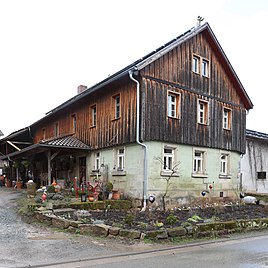Burgstall (Mitwitz)
|
Burgstall
Mitwitz market
Coordinates: 50 ° 14 ′ 35 ″ N , 11 ° 15 ′ 23 ″ E
|
|
|---|---|
| Height : | 340 m above sea level NHN |
| Residents : | 113 (1987) |
| Incorporation : | January 1, 1972 |
| Postal code : | 96268 |
| Area code : | 09266 |
|
Residential building
|
|
Burgstall is part of the municipality of the Upper Franconian market Mitwitz in the Kronach district in Bavaria .
geography
Burgstall is about four kilometers east of Mitwitz and about six kilometers west of the district town of Kronach . The street village is located at the western foot of the Wolfberb with the Heunischenburg . The federal highway 303 from Mitwitz to Kronach leads past the place. A community road leads from Burgstall to Kaltenbrunn .
history
Burgstall was first mentioned in 1142 when the Bamberg Bishop Egilbert exchanged goods with the Michelsberg Monastery . He handed over goods that were located near Kronach below Lindenberg and "Burcstal" and the Steinach River and received an estate near Niederfüllbach and a farm near Memmelsdorf . The High Middle clearing village belonged in the early modern period to the neck Court Mitwitz.
As a result of the Reichsdeputation Hauptschluss , Burgstall passed into the possession of the Electorate of Bavaria at the beginning of the 19th century . After Gemeindeedikt of 1818 that arose rural community Mitwitz, was among the among other Burgstall. In 1856 the rural community Burgstall, consisting of three places, the village of Burgstall as the main town, the hamlet of Rotschreuth and the desert of Wolfsberg, was separated from Mitwitz. In 1813 the place had 84 inhabitants and 17 houses.
In 1862 the rural community was incorporated into the newly created Bavarian district office of Kronach . In 1871 the main town had 130 inhabitants. The evangelical church and the evangelical denominational school were in Mitwitz, 3.5 kilometers away. In 1900, the 383 hectare rural community had 156 residents, 48 of whom were Catholic and 108 Protestant, and 28 were residential buildings. The main town had 97 inhabitants and 18 residential buildings. From 1912 the responsible Protestant school was in the neighboring town of Kaltenbrunn. In 1925, 176 people lived in the rural community, 119 of them in the village of Burgstall in 21 residential buildings. The Catholics belonged to the district of the Schlosskuratie in Mitwitz.
In 1950 the municipality of Burgstall had 213 inhabitants. The main town had 168 inhabitants with 23 residential buildings. In 1961, 122 people lived in 25 residential buildings in Burgstall. In 1970 the main town had 127 inhabitants and in 1987 113 inhabitants and 35 residential buildings with 40 apartments.
In the course of regional reform in Bavaria , Burgstall and Wolfsberg were incorporated into Mitwitz on January 1, 1972. Rotschreuth came to Gehülz .
literature
- Otmar Wagner: 850 years Burgstall: 1142–1992: Contributions to local history , Mitwitz-Burgstall, Mitwitz 1992, OCLC 644567596 .
Attractions
In the list of architectural monuments in Mitwitz there are 26 boundary stones for Burgstall .
Web links
Individual evidence
- ↑ a b Bavarian State Office for Statistics and Data Processing (Ed.): Official local directory for Bavaria, territorial status: May 25, 1987 . Issue 450 of the articles on Bavaria's statistics. Munich November 1991, DNB 94240937X , p. 311 ( digitized version ).
- ^ Rudolf Pfadenhauer and Heinz Köhler : 750 years of Mitwitz, documentation on the history of Mitwitz and Neundorf. Markt Mitwitz 2016, p. 20.
- ^ Rudolf Pfadenhauer and Heinz Köhler : 750 years of Mitwitz, documentation on the history of Mitwitz and Neundorf. Markt Mitwitz 2016, p. 136.
- ↑ Kgl. Statistical Bureau (ed.): Complete list of localities of the Kingdom of Bavaria. According to districts, administrative districts, court districts and municipalities, including parish, school and post office affiliation ... with an alphabetical general register containing the population according to the results of the census of December 1, 1875 . Adolf Ackermann, Munich 1877, 2nd section (population figures from 1871, cattle figures from 1873), Sp. 1057 , urn : nbn: de: bvb: 12-bsb00052489-4 ( digitized version ).
- ↑ K. Bayer. Statistical Bureau (Ed.): Directory of localities of the Kingdom of Bavaria, with alphabetical register of places . LXV. Issue of the contributions to the statistics of the Kingdom of Bavaria. Munich 1904, Section II, Sp. 1052 ( digitized version ).
- ^ Otmar Wagner: 850 years Burgstall: 1142-1992: Contributions to local history , Mitwitz-Burgstall, Mitwitz 1992, p. 80.
- ↑ Bavarian State Statistical Office (ed.): Localities directory for the Free State of Bavaria according to the census of June 16, 1925 and the territorial status of January 1, 1928 . Issue 109 of the articles on Bavaria's statistics. Munich 1928, Section II, Sp. 1085 ( digitized version ).
- ↑ Bavarian State Statistical Office (ed.): Official place directory for Bavaria - edited on the basis of the census of September 13, 1950 . Issue 169 of the articles on Bavaria's statistics. Munich 1952, DNB 453660975 , Section II, Sp. 935 ( digitized version ).
- ↑ Bavarian State Statistical Office (ed.): Official city directory for Bavaria, territorial status on October 1, 1964 with statistical information from the 1961 census . Issue 260 of the articles on Bavaria's statistics. Munich 1964, DNB 453660959 , Section II, Sp. 687 ( digitized version ).
- ^ Bavarian State Statistical Office (ed.): Official place directory for Bavaria . Issue 335 of the articles on Bavaria's statistics. Munich 1973, DNB 740801384 , p. 159 ( digitized version ).
- ^ Otmar Wagner: 850 years of Burgstall: 1142-1992: Contributions to local history , Mitwitz-Burgstall, Mitwitz 1992, p. 90.

